De Zeventiende Eeuw. Jaargang 15
(1999)– [tijdschrift] Zeventiende Eeuw, De–
[pagina 48]
| |
The artist's stage: the schilderkamer as a site of play in the 17th centuryGa naar voetnoot1
| |
[pagina 49]
| |
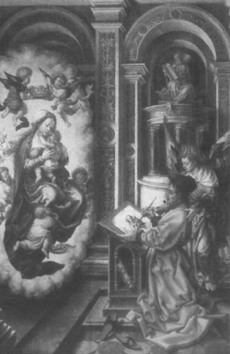
Fig. 1
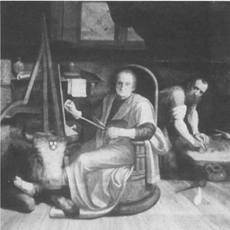
Fig. 2
this artist was the pictor doctus, who used natura (inherent talent), ars (the rules and works of old masters), and exercitatio (practice) as his sources.Ga naar voetnoot3 In many instances, the painter is depicted either in the act of painting or simply placed before the easel holding brushes and palette, as in Antonis Mor's celebrated self-portrait (Fig. 3). Prior to this time, artists were rarely depicted at work unless they were serving members of the social, religious or intellectual elite. This new pride in the profession of painter is significant, but while the painter may wield tools, they are primarily intellectual rather than manual tools. The undefined setting of Mor's self-portrait is frequently encountered in sixteenth-century portraits of the pictor doctus before his easel. Again, this displacement may be seen as a qualification of the manual aspects of the artist's craft. What I have presented may be a simplistic account of the depiction of painters at work before the seventeenth century. I have only touched on the complex issue of the changing status of the artist and the debate about the status of painting as a liberal art which informs many such images.Ga naar voetnoot4 However, I hope to have highlighted that these images present the studio as a site of work, be it the painter's divinely-inspired or intellectually based work. The instruments of this work are the painter's tools, his brushes and | |
[pagina 50]
| |
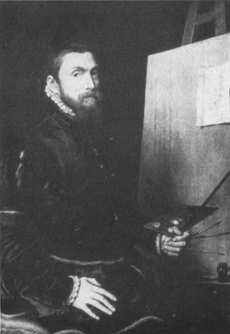
Fig. 3
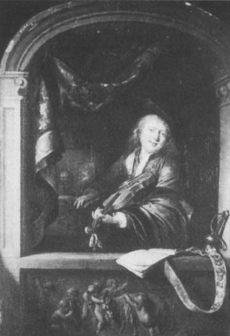
Fig. 4
palette. These are composed, moderate, arguably serious images. And in most of them, the actual studio environment is largely negated; in self-portraits the setting is usually vague and in representations of St.Luke, the setting is frequently fanciful. In the seventeenth century, images of the artist in an ostensibly recognisable studio setting proliferate. And while the studio is still represented as a place of work in many images, it also assumes a new role as a site of play, sometimes even within the same picture. This is particularly the case from around 1630 and seems to have been especially prevalent among Leiden painters in the circle of Gerard Dou, whose depiction of a violinplayer (Fig. 4) affords a view into his studio in the background. The artist is not always depicted in the act of painting and instead performs ‘roles’ which involve play in the sense of leisure: making music, drinking wine, and smoking tobacco. Nor is he consistently shown in conventional studio garb; sometimes the artist appears in antiquated or theatrical attire. Other images show the artist in the act of representing a model or group who pose like a tableaux vivant before him - while this in itself is not new, the subjects depicted are often people at play themselves. I will concentrate on these two aspects of the studio as a site of play: images of the artist in the studio shown at leisure and images which make claims about the studio as a setting for staged or represented ‘play’. Before discussing the images and textual evidence for this, I would like to explain what I mean by ‘site of play’ and distinguish this from a strictly theatrical space. This distinction is necessary because the twentieth-century conception of what constitutes a theatrical space is different from that of the seventeenth century. A strict separation be- | |
[pagina 51]
| |
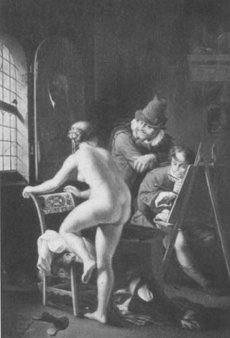
Fig. 5
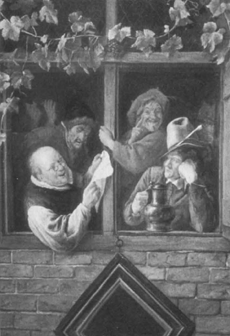
Fig. 6
tween staged performance and real-life actions, theatrical and non-theatrical spaces did not exist then as it does today. The use of the word spel or play and the contexts in which spelen are located elucidates the seventeenth-century conception of what it means to play and where it takes place. Spel could of course denote a dramatic work, a tooneel-spel intended for performance in a theatrical setting, such as Samuel Coster's play or ‘Spel van de Rijke Man’ (1615). But spel is also employed in artists' biographies to refer to incidents which are purported to have actually occurred. If something farcical happens, it might be described as a klucht or a blyspel or if something tragic transpires, it might be called a treurspel. Several incidents are described in this manner in Arnold Houbraken's compendia of artists' lives, entitled De groote Schouburgh der Nederlantsche konstschilders en schilderessen or The great Theatre of Netherlandish painters and paintresses and constructed as a tooneel or stage upon which each painter comes and plays his levensrol.Ga naar voetnoot5 He describes one such kluchtig or farcical episode in the life of Rembrandt, in which Rembrandt and his students observe a spel between a student and a naked model. The stage for this spel is the student's private cubicle in Rembrandt's studio. In this example, the studio is situated as a site for a metaphorical ‘play’ of life.Ga naar voetnoot6 | |
[pagina 52]
| |
Houbraken himself painted a picture of an artist at work depicting a nude female model (Fig. 5). While the painter, unlike Rembrandt's student, seems more concerned with work than play with his subject, his observer sure seems to take a lascivious interest! Clad in what seems to be theatrical garb, this character adds an element of play to an image otherwise concerned with the depiction of work. It follows that in its nominal form spel describes a type of performance, whether actually staged or presented as taking place on the metaphorical stage of life. Similarly, the verb spelen was used to describe engaging in a leisure activity like playing cards or making music as well as acting-out roles on the stage.Ga naar voetnoot7 So to summarise, spel is applicable to both the play-acting and leisure activities that are visualised in seventeenth-century representations of the artist's studio. The artist's studio becomes an appropriate place for such spelen or performances, because of the studio's paradoxical position between art and life, mediated through artistic creation. In turn, representations of the studio make claims about studio practice and conceptions of the basis and nature of the artist's craft. We will find that the studio is visualised as a forum for both the creation of art which depended on representing models ‘staged’ in the studio and for leisure activities. Two framing devices frequently appear in representations of the studio from around 1650 which announce a performative setting: the window or nisstuk and curtains. In Jan Steen's Rederijkers at the window (Fig. 6) the window is utilised as a stage for the performance of rhetoricians. This format can be seen to be complementary to the nisstuk format developed by Dou and widely adopted by artists in his circle including Frans van Mieris and Gabriel Metsu. In several works by these artists, a figure at play or leisure is positioned in a nisstuk in the foreground but with a view into a background which depicts an artist's studio. Such pictures tie leisure activities to the working space of the studio. Two pictures by Dou are prime examples: one depicting a violin-player in a nisstuk (Fig. 7) and the other a smoker (Fig. 8). In each, the studio setting in the background is distinguished by the presence of an easel and a man standing grinding pigments. Another man is depicted beside him, smoking. In the representation of the smoker, a trompe l'oeil curtain appears to the right of the figure, insisting on the illusionistic character of the image. A further curtain appears between the nisstuk and the background scene. In Vermeer's De Schilderkunst or The Art of Painting (Fig. 9), a large tapestry curtain is pulled back to reveal a painter at an easel depicting a woman dressed as Clio, muse of history. These curtains may be seen to announce that this is a play, a deceit, a representation. | |
[pagina 53]
| |
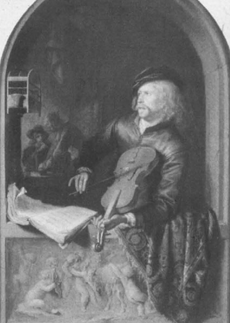
Fig. 7
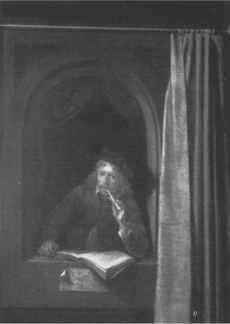
Fig. 8
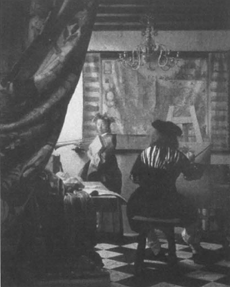
Fig. 9
The fancy clothing worn by artists in many atelier scenes also heightens the sense of play. They probably did not wear outfits like the elaborate one with slashed sleeves Vermeer dons in The Art of Painting when they were actually at work.Ga naar voetnoot8 This choice may have been informed by a desire to characterise the artist and his creative act. These outfits are | |
[pagina 54]
| |
typically a mish-mash of sixteenth century dress which would have been described as ‘à l'antique’.Ga naar voetnoot9 This term refers not to Greek and Roman costume but to early sixteenthcentury clothing, such as that usually worn on the stage. It is also the kind of clothing worn by the esteemed Netherlandish ‘old masters’ in the compendia of portrait prints of artists widely disseminated from the late sixteenth century.Ga naar voetnoot10 Adopting their ‘antique’ clothing may have been a way for seventeenth-century painters to claim affliation with early Netherlandish painters, the inheritors of the tradition and members of that artistic elite. Artists apparently did not, therefore, ‘dress up’ in antique costume in their studios. Creating an authentic ‘antiquated’ dress would have been impossible in the seventeenth century, given recourse only to the second-hand clothing market. Furthermore, ‘costumes’ rarely appear in artists' inventories. There are interesting exceptions, including some which are listed among the contents of the studio. An inventory of Rembrandt's possessions in 1656 was necessitated by his near bankrupcy and it lists ancient textiles and a pair of costumes for an Indian man and woman among the contents of his studio.Ga naar voetnoot11 But no other exotic apparel appears. Lodewijk van der Helst's inventory (1671) includes a mix of everyday clothes and costumes (significantly described as ‘antiekse’ clothing belonging to ‘de schilderkonst’), schutter or military clothing and women's clothing along with various props and gear including a Turkish pipe, including two pairs of Polish boots, six hair pieces, a veil, a walking stick, and spears. Besides these exceptional cases, artists appear not to have actually owned costumes but looked to prints, and/or supplemented this by having bolts of cloth to see how a fabric hung. They did not actually play dress-up in ‘real-life;’ their fantasies had to be mediated by and through pictures, through representation itself. Artists did, however, apparently own some tangible props, as Van der Helst's inventory above suggests. Rembrandt's inventory too lists props, most notably an impressive array of weapons and armour and a variety of musical instruments. Andries Pels characterises Rembrandt as a scavenger who searched the city for props and costumes, including helmets, furs, armor, and rags, in his Gebruik en misbruik des Toneels (Use and Misuse of the Theatre) (1681)Ga naar voetnoot12. Similarly, Houbraken confides that Rembrandt's pupil, Aert de Gelder, was an equally great scavenger who gathered large collection of clothing and props which littered his studio.Ga naar voetnoot13 While De Gelder's inventory does not, signif- | |
[pagina 55]
| |
icantly, list any props (or costumes), props do appear in other artists' inventories, including those of Jan de Heem and Philips Fruijters. The inventory of the former lists ‘Een Teucksche sabel (Turkish sword), Eenen handtboge van letterhout (a handbow made out of leather); eens Indiaens pyltken’.Ga naar voetnoot14 Military gear also appears in Ferdinand Bol's inventory, which lists a helmut and cuirass among his possessions. Besides the presence of these props in artists' inventories, another type of instrument of ‘play’, musical instruments, appear much more commonly. This is of particular significance, because, firstly, musical instruments are found regularly in artists' inventories and secondly, because they are often listed specifically as contents of the artists' studio or named alongside their easel and painting materials.Ga naar voetnoot15 The most common instrument is the violin. Examples of instruments listed in the studio or schilderkamer in artists' inventories include: Pieter Codde (1636), ‘een oude Luijt’ and ‘een fiool’; Jan Miense Molenaer (1668) ‘een fiool’; Michiel van Musscher (1705), ‘Een fiool de gambo en een gietar, Twee cieters, een harp, 2 handfioolen, Een lier en een sakpijp’.Ga naar voetnoot16 Antonio I de Succa's 1620 Antwerp inventory includes ‘Een groote ende een cleyn citer met een een [sic] custodie’ recorded next to his easel and materials in the ‘Gaelderyecamerken’.Ga naar voetnoot17 And in the same room as the props and costumes listed above in Lodewijk van der Helst's inventory are a large ‘basviool’, a violin, two lutes, and a cyther. The studio is regularly depicted as the site of recreational ‘play’ and relaxation. Artists are frequently shown in playful dress making music by their easels. A painting by Johannes van Swieten (Fig. 10) shows a painter in fancy dress playing the lute, looking vacantly upwards and leaning his arm on a table where a large glass of wine and his palette rest. On the other side of the easel are two figures at work, a young assistant grinding pigments and what may be the same painter instructing him, work which may be meant as a contrast to the ‘play’ of the painter-musician. While representations such as this of the artist making music in his studio have been interpreted as negative moralising allegories against worldliness and lust, it is possible that some of these images may be invoking both the relaxing and inspiring properties of music promoted by contemporary theorists.Ga naar voetnoot18 Theorists associated music and painting through the relationship between musical harmony and proportion and perspective in painting. | |
[pagina 56]
| |
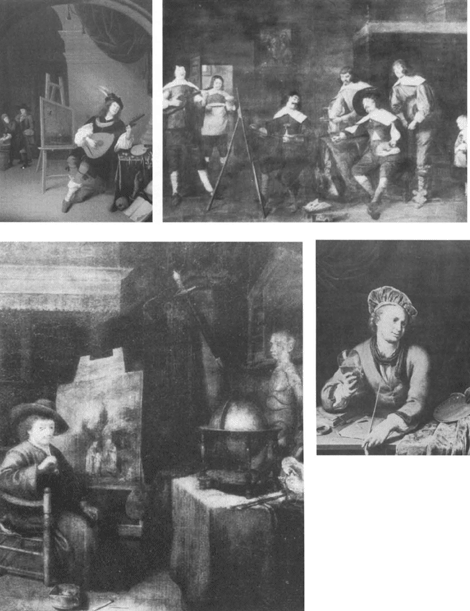
Fig. 10-13
The topoi of the artist-musician appears throughout the lives of artists, from Van Mander to Houbraken and Weyerman, where music-making is accorded a positive role in artists' lives as a vehicle of inspiration and relaxation. Music is shown to complement and characterise their artistry as painters. Houbraken relates that Gerard de Lairesse, championed as the exemplar of the learned painter, played the violin before his easel for poetic inspi- | |
[pagina 57]
| |
ration before embarking on his composition.Ga naar voetnoot19 Three of Pieter van Laer's biographers describe how the painter played the violin in front of his easel to lift his spirits and awaken his mind.Ga naar voetnoot20 Music was also considered a suitable means of entertaining subjects.Ga naar voetnoot21 Musicmakers occasionally appear in the company of a working painter, for example the singing figure behind the easel in Joos van Craesbeeck's Painter in his studio (Fig. 11). Smoking and drinking also feature in representations of painters in their studios, showing them relaxing from their studio-work. Again, smoking and drinking have been seen to be inappropriate activities for the pictor doctus and therefore interpreted negatively.Ga naar voetnoot22 However, like music, smoking and drinking were both believed by contemporaries to have positive, healing and even inspirational powers if done in moderation.Ga naar voetnoot23 Jacob van Spreeuwen's Pipe-smoking painter in his studio (Fig. 12) depicts a painter relaxing before his easel by smoking his pipe. A table beside him shows a selection of props, including a violin bow. Willem van Mieris also represents a painter smoking (Fig. 13), identified by the presence of palette and brushes in the foreground and an easel faintly visible in the background. He precariously tips a large filled roemer in his right hand and holds an elegant long pipe in his left. Proceeding to the next theme of ‘play’ in the artist's studio, some pictures make claims about the studio as a space for ‘staged’ representation. Models of course posed and enacted their represented roles in the artist's studio. In two images of the painter with his model, one by Willem van Mieris (Fig. 14) and the other by Simon Kick (Fig. 15), the ‘staged’ space of the model/setting is visually delineated from that of the painter by the easel and a curtain swathe appears over the heads of the two models. In Van Mieris' picture, the subject is also shown on a covered raised platform. David Rijckert III's Painter in his studio (Fig. 16) also shows a painter depicting a merry-making figure that sits posed before him in his studio, shown with a tankard and a pipe. Although there is no curtain above his head, there is a separation of the performance space suggested by the wooden partition that enframes him. As in the Kick work, the painter's brush touches the figure that sits before him, claiming authorship. In this case, the subject is shown on the canvas beside two others. So while the painting on the easel presents a unified image of three figures together in a landscape, the group did not necessarily even sit together. Joos van Craesbeeck's Painter in his studio (Fig. 17) again | |
[pagina 58]
| |
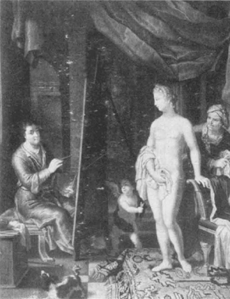
Fig. 14
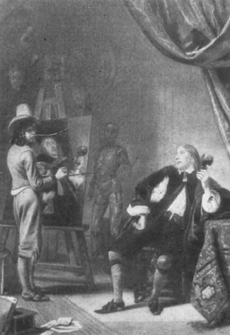
Fig. 15
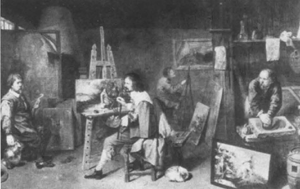
Fig. 16
shows the artist depicting a merry company group that pose before him, consisting of a man playing the lute, a lady singing, a man holding a glass of wine, a couple, and a standing smoker. Finally, an image by Jan Miense Molenaer (Fig. 18) shows the artist in his studio with his subjects at play after the performance, including a midget playing with a dog in the foreground and an old man making music behind. The artist is shown on the left, still holding his palette and pointing toward his subjects with his brush. The subjects are shown again in the painting displayed on the easel. These are images which explicitly claim that pictures are staged in the studio. The artist's model frequently seems to embody the source of the artist's inspiration: whether it is the Virgin and Child in im- | |
[pagina 59]
| |
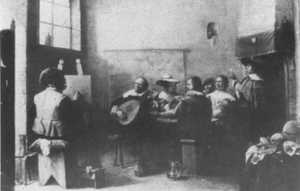
Fig. 17
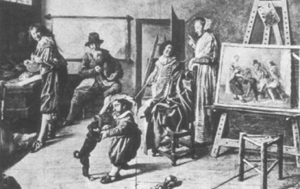
Fig. 18
ages of St. Luke (divine), Campaspe in images of Apelles (love), Clio in Vermeer's Schilderkunst (history), and here music-players, smokers, and drinkers in these images (music, tobacco, wine). The pictures I have described visualise the studio as a site of recreational play and as a stage for the ‘representational’ play between the painter-director and the model-actor. I have mentioned how Houbraken used Rembrandt's studio as a site for a metaphorical ‘play’ between a student and a model. I will now conclude by briefly returning to the original sub-title of this paper: the schilderkamer as a theatrical space. There is some evidence that the studio was literally used as a site of performance by painters themselves. According to Houbraken, Samuel van Hoogstraten, who was his teacher, used his attic as a theatre for his pupils to perform plays as part of their training.Ga naar voetnoot24 Teaching acting to pupils as a part of the learning process could perhaps be related to Latin School education, where it was standard practice to teach students rhetoric and acting in the seventeenth century.Ga naar voetnoot25 This model of the theatre is interesting in that it was conceived primarily without the expectation of an audience, though Houbraken says that occa- | |
[pagina 60]
| |
sionally family and friends were invited to performances. In his didactic treatise on painting, Inleyding tot de hooge schoole der schilderkonst (1678), Van Hoogstraten advises history painters to employ acting techniques in order to effectively depict the passions in history painting, famously saying that ‘one must reform oneself totally into an actor’. Presumably, his ‘performances’ would occur in his studio as part of the working process. He also encourages painters to do a mock-up in the studio with two or three assistants in order to find a good arrangement of figures. These ‘kamerspel[en]’, he says, have been used as a creative tool by many great masters.Ga naar voetnoot26 Despite such references, I am not aware of any images which explicitly depict the studio as a theatrical space. But I hope to have shown how it is visualised as a stage for representation, where the artist is the director, and a site for recreational play, where the artist himself is a player. Ultimately, by drawing the analogy between the stage and the studio, these highly self-referential images address the status of painting as a manufactured reality. They insist that painting, like a stage, is a playful deceit. The ‘spel’ of these images is then finally not only the play of entertainment but also the engaging play of reality and deceit. Abstract - Invoking two conceptions of spel, as play-acting and as leisure, this paper will consider how the schilderkamer or artist's studio was represented as a site of play in the seventeenth century. Both visual representations and textual documentations of the artist's studio demonstrate this. Visual representations of the artist's studio are often shown littered with props and demarcated by theatrical curtains or niches. The artist who inhabits this space is not always depicted in conventional artist's attire and in the act of painting. Many images depict the artist in theatrical or antiquated dress within this space, performing ‘roles’ which involve ‘play’ in the sense of leisure: making music, drinking wine, and smoking tobacco. Others show the artist in the act of ‘representing’ a model/group before him. |
|

